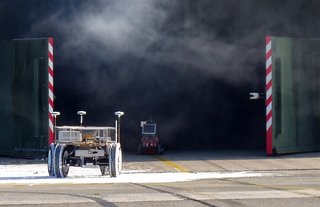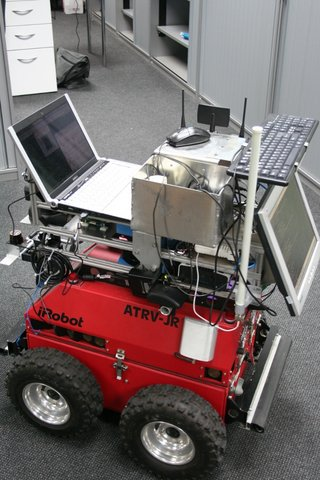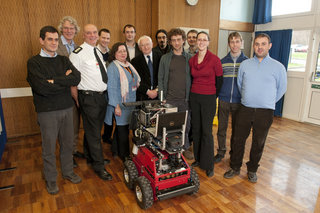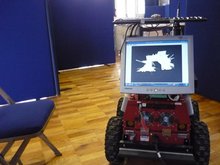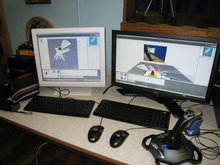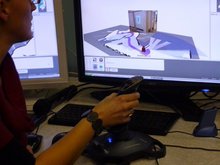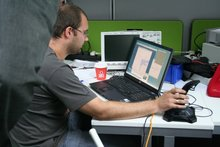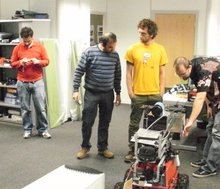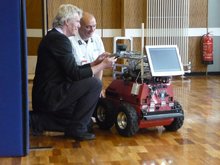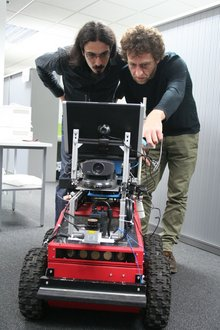VIEW-FINDER
From MMVLWiki
| Table of contents |
The VIEW-FINDER project
The View-Finder project was a successfully completed EU-FP6 project (grant number 045541 (http://cordis.europa.eu/fetch?CALLER=PROJ_ICT&ACTION=D&CAT=PROJ&RCN=80499)) in Advanced Robotics (IST-2005-2.6.1), executed from 2006-12-01 to 2009-11-30. The final demonstrations took place in January 2010 at South Yorkshire Fire and Rescue training (http://www.syfire.gov.uk/432.asp) grounds (Sheffield, UK). The final project report is available here (http://shura.shu.ac.uk/2171/2/VFFinal_ReportJune.pdf).
Summary
In the event of an emergency, after a fire or other crisis event has occured, a necessary but time consuming pre-requisite, that could delay the real rescue operation, is to establish whether the ground can be accessed / entered safely by human emergency workers. This was the context under which the project was initiated.
- Disclaimer: In this page you will be viewing pre-dominantly the indoor scenario even though we have tried for most of the information provided herein to be from the project as a whole. To the best of our knowledge the information provided herein are correct at the time of publication. However, the views or claims expressed in external links provided herein are not directly endorsed by Sheffield Hallam University. If you find any mistakes or omission please contact MMVL (details at the main MMVL wiki-page).
- Advisory: You are advised to visit the official VIEW-FINDER (https://www.view-finder-project.eu/project-results/results) page: "Vision and Chemi-resistor Equipped Web-connected Finding Robots".
- Pictures: all pictures present in this page have been taken from members of the MMVL and the consortium as a whole. Pictures from members of the consortium, may have different copyright notices than the ones provided by the MMVL. External source of project pictorial items are available either VIEW-FINDER here (https://www.view-finder-project.eu/project-results/results) or here (http://www.dis.uniroma1.it/~carbone/pages/Pictures/Pages/Viewfinder_2007-2011.html#grid).
Notifications and Announcements
- Final project report - 15 July, 2010: the final project report, amended and updated, is available here (http://shura.shu.ac.uk/2171/2/VFFinal_ReportJune.pdf).
- Successful completion - 05 July, 2010: According to the European Union panel's Review Report the project contribution is 'sufficient' and the overall testing, experimentation and results dissemination are 'good'. The works on depth recovery and point-cloud rendering were deemed to be 'promising' and 'novel', though 'ongoing'. Minor changes on the final report were recommended.
- Successful demonstrations - 19th Jan 2010: The project demonstrations were deemed 'sufficient' and overall 'successful'. The EU review panel congratulated the project integration efforts and the presented solution.
- Final dissemination event: IARP workshop RISE 2010 at Sheffield Hallam University on 20-21 January 2010.
General Description
   
|
VIEW-FINDER was a field (mobile) robotics project (European-Union, Framework-VI: Project Number 045541), consisting of 9 European partners, that investigated the use of semi-autonomous mobile robot platforms to establish ground safety in the aftermath of fire incidents. The project was coordinated by the Materials and Engineering Research Institute (http://www.shu.ac.uk/research/meri/) at Sheffield Hallam University and officially ended on 30th November 2009, final review, reports and demos took place on the 18th Jan. 2010. The review that took place on the 19th Jan 2010 judged the project as 'successful'.
The objective of the VIEW-FINDER project was to develop robots which have the primary task of gathering data to assist the human interveners in taking informed decisions prior to entering either an indoor or outdoor area. Thus the primary aim was to gather data (visual, environmental and chemical) to assist fire rescue personnel after a disaster has occured. A base station combined the gathered information with information retrieved from the large scale GMES-information bases. Issues addressed, related to: 2.5D map building, localisation and reconstruction; interfacing local command information with external sources; autonomous robot navigation and human-robot interfaces (base-station).
Partners PIAP, UoR, SHU and IES were pre-dominantly involved in the indoor scenario and RMA, DUTH predominately involved in the outdoor scenario; with SAS and SyFire being involved in both.
System description
The developed VIEW-FINDER system was a semi-autonomous system; the individual robot-sensors operate autonomously within the limits of the task assigned to them. That is, they autonomously navigate from two assigned points by planning their path and avoid obstacles whilst inspecting the area. Henceforth, the remote central operations control unit assigns tasks to the robots and monitors their execution, with the ability to intervene at any given time. Inasmuch, central operations control has the means to renew task assignments or provide further details on tasks of the ground robot. System-human interactions at the central operations control were facilitated through multi modal interfaces, in which graphical displays play an important but not exclusive role.
Although the robots had the ability to operate autonomously, human operators monitor the robots' processes and send high level task requests, as well as low level commands, through the human-computer interface to some nodes of the ground system. The human-computer interface (base station) had to ensure that a human supervisor and human intervener on the ground, are provided with a reduced yet relevant overview of the area under investigation including the robots and human rescue workers therein.
The project comprised of two scenarios: indoor and outdoor, with a corresponding robot platform for each scenario. The indoor scenario used a heavily modified ATRV junior robot platform that used to be available from iRobot (http://www.irobot.com/uk/government_industrial.cfm) and a purpose built outdoor robot based on the RoboSoft (http://www.robosoft.com/eng/categorie.php?id=1009) mobile platforms.
The indoor robot was equipped with two laser range finders, one of which was attached to a tilt unit for providing 3D acquisition, a front sonar array, a pan-tilt-zoom camera, a chemical sensor array and a long range wireless communication device. Apart from the existing robot processing unit (Ubuntu 8.04), there were added another two processing units (one with winXP and one with Ubuntu 8.10). The low level control of the robot and behaviour (e.g. obstacle avoidance and navigation) was achieved via the pre-existing processing unit whilst the data processing for the purposes of mapping and localisation were placed on the additional linux unit. The winXP unit was used whenever windows specific (proprietary) software items had to be deployed. All robot collected data were forwarded to an ergonomically designed base station.
The software platform for the robots was as follows:
- indoor robot (both WinXP and Ubuntu 8.10) was a hybrid that used Player 2.1.2 and Corba as the robot hardware communication layer and IES Mailman for wireless data transmission layer (UDP/IP; packing, fragmentation) to the base station
- outdoor robot used solely WinXP and Corba through the RMA partner's modification layer known as Coroba
In both cases, great effort was dedicated on the integration of hardware and software modules.
Project Partners
Coordinator
- SHU: Sheffield Hallam University, Materials and Engineering Research Institute (MERI, MMVL), Sheffield, United Kingdom
- Work predominantly in the indoor scenario (management, integration, mapping, chemical sensors)
Academic Research Partners
- RMA (Outdoor scenario): Royal Military Academy (http://www.rma.ac.be/) - Patrimony, Belgium
- Work predominantly on the outdoor scenario (robot platform, architecture, navigation, localisation)
- DUTH: Democritus University of Thrace (http://robotics.pme.duth.gr/) - Xanthi, Greece
- Work predominantly in the outdoor scenario (stereo vision, compression, navigation)
- UoR: Sapienza University of Rome (http://www.dis.uniroma1.it/~alcor/), Italy
- Work predominantly in the indoor scenario (localisation and mapping, communication, integration)
- PIAP: Industrial Research Institute for Automation and Measurements (http://www.antiterrorism.eu/), Poland
- Work predominantly in the indoor scenario (robot platform, architecture, integration, navigation)
Industrial partners
- SAS: Space Applications Services (http://www.spaceapplications.com/), Belgium
- Work on both indoor/outdoor scenarios (management, integration, base station)
- IES: Intelligence for Environment and Security SRL (http://www.i4es.it/) - IES Solutions SRL, Italy
- Work predominantly in the indoor scenario (communications protocol software and wireless transmission hardware)
- SyFire: South Yorkshire Fire and Rescue Service (http://www.syfire.gov.uk/), United Kingdom
- Work on both indoor/outdoor scenarios (logistics)
- GA: Galileo Avionica -S.P.A., Italy
- Work predominantly in the indoor scenario (management)
Project outputs and dependencies
- Project deliverables are available here (https://www.view-finder-project.eu/project-results/list-of-public-deliverables); public deliverables can be accessed therein.
- Using robots in hazardous environments (http://www.woodheadpublishing.com/en/book.aspx?bookID=2041)

Selected Publications
- L. Alboul and G. Chliveros (2010). A System for Reconstruction from Point Clouds in 3D: Simplification and Mesh Representation, Proceedings of the International Conference on Control, Automation, Robotics and Vision (ICARCV 2010), Dec 2010 Singapore.
- G. De Cubber, D. Doroftei, S.A. Berrabah and H. Sahli (2010). Combining Dense structure from Motion and Visual SLAM in a Behavior-based Robot Control Architecture, International Journal of Advanced Robotics Systems 6(1): 11-23.
- L. Nalpantidis and A. Gasteratos (2010). Stereo vision for robotic applications in the presence of non-ideal lighting conditions, Image and Vision Computing 28: 940-951.
- L. Nalpantidis and A. Gasteratos(2010). Biologically and Psychophysically Inspired Adaptive Support Weights Algorithm for Stereo Correspondence, Robotics and Autonomous Systems 58: 457-464.
- G. Echeverria and L. Alboul (2009). Shape-preserving mesh simplification based on curvature measures from the Polyhedral Gauss Map, International Journal for Computational Vision and Biomechanics 1(2): 55-68
- J. Bedkowski and A. Maslowski (2009). NVIDIA CUDA Application in the Cognitive Supervision and Control of the Multi robot System Methodology for the supervision and control of the multi robotic system with CUDA application, Handbook on Emerging sensor and Robotics Technologies for Risky Interventions and Humanitarian de-mining (book series: Mobile Service Robotics, Woodhead Publishing).
- U. Delprato, M. Cristaldi and G. Tusa (2009). A light-weight communication protocol for tele-operated Robots in risky emergency operations, Handbook ‘Emerging sensor and Robotics Technologies for Risky Interventions and Humanitarian de-mining (book series: Mobile Service Robotics, Woodhead Publishing Company).
- G. De Cubber (2008), Dense 3D structure and motion estimation as an aid for robot navigation, Journal of Automation, Mobile Robotics & Intelligent Systems 2(4): 14-18
- D. Doroftei, E. Colon and G. De Cubber (2008), A behaviour-based control and software architecture for the visually guided robudem outdoor mobile robot, Journal of Automation, Mobile Robotics & Intelligent Systems, 2(4): 19-24
- S. A. Berrabah and E. Colon (2008). Vision – based mobile robot navigation, Journal of Automation, Mobile Robotics & Intelligent Systems, 2(4): 7-13
- A. Carbone, A. Finzi, A. Orlandini and F. Pirri (2008). Model-based control architecture for attentive robots in rescue scenarios. Autonomous Robots 24: 87-120
- L. Alboul, B. Amavasai, G. Chliveros and J. Penders (2007). Mobile robots for information gathering in a large-scale fire incident. IEEE 6th (SMC UK-RI) Conference on Cybernetic Systems (Dublin, Ireland): 122-127.
- A. Carbone, D. Ciacelli, A. Finzi and F. Pirri (2007). Autonomous Attentive Exploration in Search and Rescue Scenarios. In: Attention in Cognitive Systems; theories and systems from an interdisciplinary viewpoint, pp. 431 - 446
Software that has proven useful
- System architecture/integration
- The PlayerStage robot software platform (http://playerstage.sourceforge.net/wiki/Main_Page)
- Real-time CORBA with TAO/ACE (http://www.cse.wustl.edu/~schmidt/TAO.html)
- IES Wireless Solution Mailman (PWD protected) (http://viewfinder.i4es.it/index.php/Main_Page)
- JUCE: Framework for writing user interfaces (http://www.rawmaterialsoftware.com/juce/)
- SWIG: The Simplified Wrapper and Interface Generator (http://www.swig.org/)
- Mapping / Localisation and Reconstruction
- A plethora of resources on the Simultaneous Localisation and Mapping Problem (http://www.openslam.org)
- Mobile Robot (C++) Programming Toolkit (http://babel.isa.uma.es/mrpt/index.php/Main_Page)
- Computational Geometry Algorithms Library (http://www.cgal.org/)
- OpenCV: Computer Vision Library at Willow Garage (http://opencv.willowgarage.com/wiki/)
- GNU Octave: integrating m-functions in C++ (http://wiki.octave.org/wiki.pl?CodaStandalone)
- Magick++ Library: Image manipulation and compression (http://www.imagemagick.org/Magick++/Documentation.html)
Videos and demonstrations
|
A prototype of the ViewFinder SLAM procedure based on an SIR-RB particle filter implementation: ladar and odometry data collected via the Player software platform.
|
A video demonstration of the base-station controlling the ATRV-Jr robot through the Human-Machine interface. Different views and control means are shown.
|
| coming soon
|
Final demonstration for the outdoor scenario: general views and description of the full rescue scenario. A glimpse of the indoor ATRV-jr robot (PIAP) can also be seen.
|
|
Nitrogen gas evolution in a room-fire scenario (simulated with NIST's FDS-SMV); a vertical and horizontal plane are only shown with the fire start indicated by a yellow patch.
|
South Yorkshire Fire & Rescue: the Realistic Fire Training Building (RFTB), a new state of the art training facility located at SYFR's Training and Development Centre.
|
See Also
- Project publicity (UK)
- GUARDIANS and VIEW-FINDER exhibit in London science museum (http://www.sciencemuseum.org.uk/antenna/firefightingrobots/)
- VIEW-FINDER project on local newspaper (http://www.thestar.co.uk/news/Robot-feeling-the-heat.5502210.jp)
- Article on Professional Engineering (http://vision.eng.shu.ac.uk/mmvlwiki/index.php/Image:ProEngineering.jpg)
- Other projects
- GUARDIANS
- DHRS-CIM
- HornetsEye: Computer Vision for the Robotic Age (http://www.wedesoft.demon.co.uk/hornetseye-api/files/HornetsEye-txt.html)
- ROS: Robot Operating System by Willow Garage (http://www.ros.org/wiki/)
- Robot platforms
- Earthquake Rescue Robots (http://news.bbc.co.uk/1/hi/sci/tech/8069435.stm)
- CHRYSOR (http://www.robowatch.de/index.php?id=303)
- PIAP Military INSPECTOR (http://www.antiterrorism.eu/remote_operated_vehicle.php)
- Mobile Robots Inc. Seekur Jr [1] (http://www.youtube.com/watch?v=e-q9kU6wN9c&feature=player_embedded)[2] (http://www.youtube.com/watch?v=GNuPPkRXHxE)
- Robotnik Guardian rover robot (http://www.robotnik.es/en/products/mobile-robots/guardian) platform
- RoboSoft RobuROC-4 (http://www.robosoft.com/eng/popup_video.php?video=1016)
- Other related links
- EU Cordis project entry (http://cordis.europa.eu/search/index.cfm?fuseaction=proj.document&PJ_RCN=9059633)
- NASA Three-Robot System for Traversing Steep Slopes (http://www.techbriefs.com/component/content/article/5779)
- BBC news: robotic firefighting (http://news.bbc.co.uk/1/hi/technology/8172739.stm)
- Channel 4 News: Rise of the Machines? (http://www.channel4.com/news/articles/science_technology/rise+of+the+machines/3286757)
- Robot mining trucks (http://dsc.discovery.com/news/2008/11/06/monster-robot-truck.html)
- Robots can jump... (http://www.examiner.com/x-8134-SF-Gadgets-Examiner~y2009m9d15-Military-robot-can-jump-over-25-foot-walls)
- DEFACTO fire-training software (http://viterbi.usc.edu/news/news/2007/computer-science-thesis.htm)
- NIST Christmas tree fire video (http://www.youtube.com/watch?v=2hleYtLNIOw)
- NIST's FDS-SMV fire dynamics simulator (http://www.fire.nist.gov/fds/) (also see comparison of real and simulated fire (http://www.fire.nist.gov/fds/comparison_examples.html))
